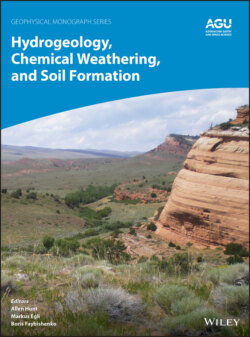Читать книгу Hydrogeology, Chemical Weathering, and Soil Formation - Allen Hunt - Страница 23
1.3.3. Soil Energy System
ОглавлениеCoexisting with the material soil system is an energy exchange and storage system (Lin, 2011). Thermal energy (heat) is stored in the soil. The soil system gains heat from incoming solar radiation, terrestrial radiation emitted by the atmosphere, possibly from incoming soil materials and from exothermic reactions; it loses thermal energy in emitting radiation, by conduction out of the system, in outgoing soil materials and in endothermic reactions. Potential energy of a chemical or elevational nature is also stored, imported, and exported. Energy transfers in the soil are brought about by heat conduction, by convection associated with water and air movements, and by translocation of materials. Energy transformations in the system occur in chemical alterations, biological activity, wetting and drying, freezing and thawing, and evaporation and condensation in the soil atmosphere.
The soil energy system is not as well studied as the soil material system, but there are some interesting investigations (Table 1.1). A few researchers have developed models that considered the energy involved in weathering and soil formation, and in doing so quantify the climatic factor of soil formation though such measures as organic matter production and the amount of water available for leaching (Runge, 1973); the energy expended in soil formation (Volobuyev, 1963; Regan, 1977); a measure of the effective energy and mass transfer to the subsurface that accounts for local variations in topography, water and energy balances, and primary production (Rasmussen et al., 2005; Rasmussen & Tabor, 2007; Rasmussen et al., 2015); a probabilistic approach for quantifying soil property variability through integrating energy and mass inputs over time (Shepard et al., 2017); and a review of energy and entropy in near‐surface Earth systems (Quijano & Lin, 2014).
